
 |
|
|||||||
| Home | Forums | Gallery | Register | Video Directory | FAQ | Members List | Calendar | Games | Today's Posts | Search | Chat Room |
  |
|
|
Thread Tools | Display Modes |
|
#1
|
||||
|
||||
|
All mass-engaged components of WW1 field artillery had been "shot" during the first two month of the war, due to false pre-war-plannings that future wars should last only 90 days on the European theatre of war. As long as supply of peace-time produced ammunition was available, none of the related powers artillery arms made any technical troubles concerning their ammunition, inclusive pertinent projectile-fuzes, as the mobile warfare required similar technical sufficiencies on artillery-ammunition and fuzes as exercised for in peace time.
Initially, the German Army’s field artillery used the extremely expensive “Einheits-Munition”(General Purpose Ammo) introduced commencing 1905 for the 105mm Howitzers and 1911 for the 77mm field-cannons - an object that will be subject to separate elaborate detail. Additionally, the even more expensive “Zünder für Einheitsgeschosse” (Fuzes for GP-Projectiles) had to be used. These mechanical masterpieces incorporated 4 separately activatable functions (Impact with or without delay, Shell/Shrapnel time-fuze-function) and could be produced only by the Imperial Laboratories at SIEGBURG and SPANDAU in very restricted numbers due to their complexity. With the field-cannon (F.K.96 n.A.) – until Sept. 1914 – the following introduced projectiles and fuzes were available: “Deutsche Feldgranate 96” (F.Gr.96) cal.77mm and the “Deutsches Feldschrapnell 96”(F.Schr.96) with “Doppel-Zünder 96”(D.Z.96) (dual purpose fuze, time/impact) or the “D.Z.98” for the field howitzer “leichte Feld-Haubitze 98/09 (l.F.H. 98/09) respectively. All above mentioned fuzes were so-called “inert” fuzes with the setting “impact”, i.e. the projectile “entered” the ground at least 1/3rd of its length before detonating. Thus, the produced “effective fragments” (a fragment is effective if it clearly perforates a steel sheet-metal of 1,5mm thickness and a tensile strength of 1600 N/mm² - steel-helmet quality) had a range of about 10m left and right plus 7,5m before and 2.5 m behind the point of impact covering an area of about 170m² of the battle-field. After the mobile-warfare part of the war “trench-warfare” dominated and urgent need was felt for heavy, medium and light mortars that could be “man-handled” in the trenches and over the “no-man’s-land”. With the beginning gas-warfare, additional mass-firing-devices had to be deployed at major scale (for the low-brisant gas-cannisters) to provide highest gas-concentration with the enemy in order to “break the mask” i.e. to penetrate the protective filter-systems of the gas-protective gear. To meet the demands of the gigantic shooting supplies of the trench warfare, all nations set to work simultaneously to provide the front massively with any nearly useful weaponry to create something like a ballistic trajectory: The French scaled down field-artillery to trench-artillery (20-37mm cal) and invented fin-stabilized mine-throwers of all scales (58-240mm), Great Britain took back in service the out-moded COEHORN-mortars that had seen service as early as 1746 at the battle of CULLODEN end developed the primitive STOKES- Mortar and the LIVENS-Projectors, Axis-Powers invented all sort of primitive mortars that had to be replaced in the end of 1915 and some “bright stuff” like the “Priester-Werfer”(“priest-mortar”, French nickname: “tourterelles”(dovelets). and the Austrian compressed-air projectors in various calibres as well as the concrete made 18cm gas-projectors used up to the last week of the war to poison the BOURLON-Forest near CAMBRAI in Oct. 1918 All these makeshift shooting-supplies had one common draw-back: the ordnance fired lacked of sufficient stabilization so that the projectiles tumbled-over during their trajectory and thus very often produced “duds” by not impacting properly with the “nose”. The British referred to these projectiles as “flying pigs”. In connection with the deep soils of Flanders, Verdun an the Somme-lowlands, partly up to 40% duds were produced, an intolerable percentage on the more as nearly every week new explosive compounds or newly developed gases had been used against the enemy that literarily only had to “pick-up” the non-exploded ordnance for analysis at the home-based laboratories for evaluation. Thus, “Gelbkreuz” (a.k.a. „Lewisite“ in GB and „Yperite“ in France and the USA) had been revealed to the enemy only 7 days after initial German use. Besides, a painful lack of copper-related materiel could be felt by the axis-powers with prolonged periods of war. These metals had been very important in producing fuzes and cartridge-cases as said metals are anti-static, low-corrosive, very ductile at good tensile strength with very good elasticity & being self-lubricant to a wide extend. Therefore new fuzes had to be invented and produced that detonated the main-charge not only on “nose-impact” but also at base- or side-impact. On that behalf GB & F employed so-called “sensitive” arty-fuzes (called SQ for super quick) like Austria and Italy, only to gain a crisp 5% improvement of lessening the dud-rate. With the british STOKES-Mortar-Bombs which used a re-constructed british “Mill's Bomb Detonator", from November 1915 to March 1917 the setting-man at the gun had to cut down the time-marked-fuze on every bomb for the expected impact-time, clip the fuze to the detonator base (by means of pliers in the trench!) and screw home the fuze assy to the bomb-body. About 5000 “loading-accidents” had to be recorded on this subject resulting in at least 1 mutilation and/or severe casualties in every case. 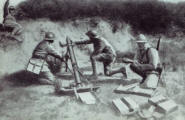 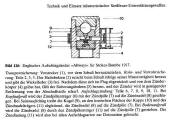  Germany created a thorough solution of the problem by developing an entire “mortar-family!”under the supervision of Dr. CARL VÖLLER of RHEINMETALL. Though Germany already had some heavy mine throwers 250mm (s.M.W.)(1910) and medium Mine-Throwers 170mm(m.M.W.) 1913 with the German siege-artillery, a light weapon for the trench-warfare was under way. During these trials Dr. VÖLLER paid the highest price during a lethal accident with new 250mm Mortar-Ammo through a bore-burst on the 16th March 1916 when testing new grenade-body-tubing. His most important heritage was the co-founding of the ZÜNDAPP-plant at Nuremberg, (Deutsche Zünder- und Apparatebau Gesellschaft) („German Fuze- and Apparatus-Construction Ltd.“) which’s initially single purpose has been the production of the „Wurf-Minen Zünder 16”, (Fuze, Mine-Thrower1916”) . This first “all-ways-fuze” established a completely new breed of fuzes to be adjusted with the same key and same fuze on all German Minenwerfer and all Calibers. 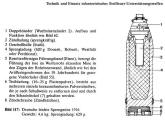 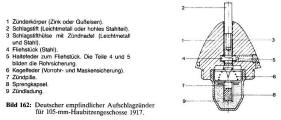 Nearly simultaneously (December 1916) new SQ (SuperQuick) fuzes for both field-cannon and field-howitzer have been introduced. (Empfindliche Aufschlagzünder 17) (“sensitive Impact Fuze 17”). Their very simple construction without any nonferrous heavy metal (steel and aluminium only) was congenious. The entente parties copied or developed their own solutions to the SQ-fuze parallely or in short time subsequently: GB: “Impact Fuze, SQ”, No.3, No.44, No.101 E, and from mid 1916 the then standard Model No. 106 . All said models are independent and autonomous developments of Lord Kitcheners Ministry for Ammunition. All fuzes are membrane type. France's answers were ”Fuzée Instantantanée” or “Fuzée Longue Mle 1915” and “Fuzée Mle 1917”. 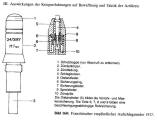 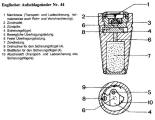 All these SQ-fuzes were designed to deliver instantaneous detonation of enhanced charges upon impact (>= 0.01sec.) so that set-free fragments were accelerated flat over the ground and “taking cover” was not helpful every time. 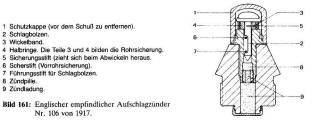 By these developments, impact fuzes underwent all major constructional alterations to deliver the state-of the-art maximum performance in dependability and speed of detonation. Until today, only minor alterations have been made to compensate for the latest insights of aerodynamics. |
| Sponsored Links |


|